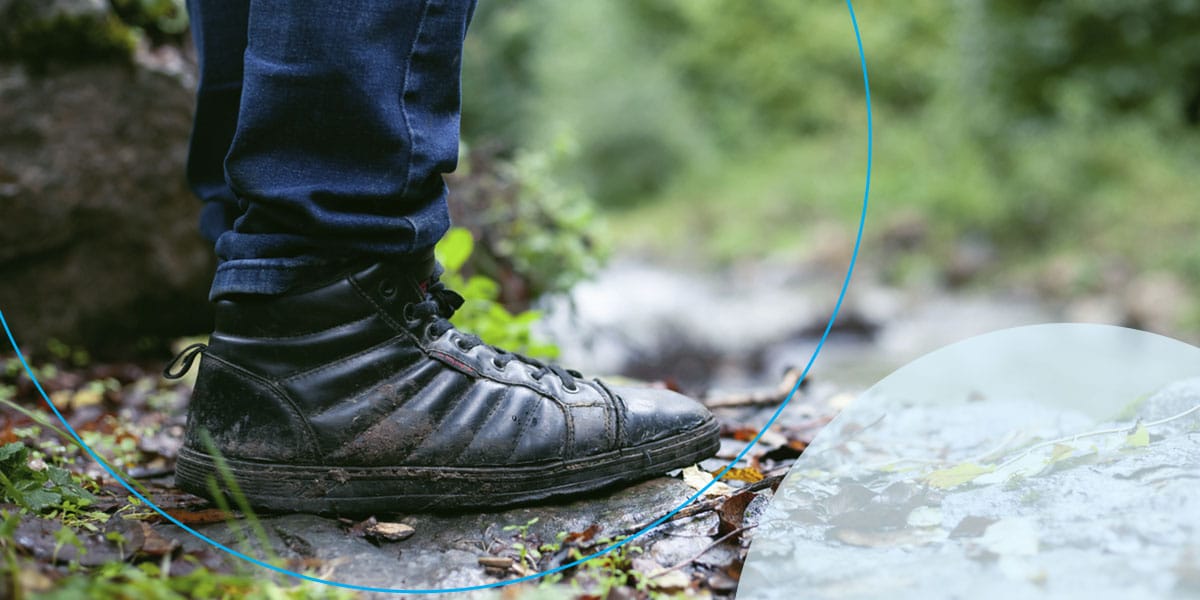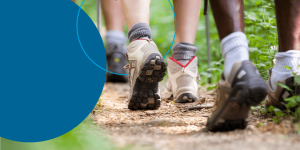If you spend much time outdoors, you know how wet weather can wear on your feet. It’s not just the discomfort of soggy socks or cold toes. Damp conditions create an environment for skin breakdowns, infections and various foot issues, especially if you have existing foot issues.
The right hygiene practices, gear choices and medical care can protect your feet and keep you moving.
Explore how to care for your feet in wet weather.
Effects of Wet Weather on Foot Health
Wet conditions are uncomfortable and affect circulation, skin integrity and susceptibility to infection. Prolonged moisture exposure negatively impacts your feet in the following ways:
Reduces Circulation
Cold, damp conditions constrict blood vessels. This is your body’s natural attempt to preserve core temperatures, but it also reduces blood flow to the feet. Poor circulation slows healing and weakens your body’s ability to fight infection. It also results in less oxygen and nutrients getting to your feet.
If you already have diabetes or peripheral artery disease, wet weather can exacerbate your symptoms.
Damages the Skin and Causes Blisters
When feet are wet, the skin becomes fragile and more likely to break under pressure or rubbing. When you experience friction from shoes or socks unsuitable for wet weather, blisters can form. Repeated exposure to friction causes calluses. For people who already deal with corns, bunions or sensitive pressure points, wet skin worsens these problem areas.
Additionally, compromised skin integrity allows bacteria to enter more easily.
Increases the Risk of Infections
Damp environments are a breeding ground for fungi and bacteria. When moisture gets trapped between toes, under the nails or in soaked socks, it becomes much easier for conditions like athlete’s foot or fungal toenails to occur.
Fungal infections thrive in warmth and moisture, especially when you wear nonbreathable shoes all day. Cracked skin becomes an entryway for bacterial infections, which can worsen if untreated. Those with compromised immune systems or existing health conditions are susceptible to infection complications.
Worsens Existing Conditions
For anyone already managing plantar fasciitis, arthritis or diabetic foot concerns, wet weather can worsen these conditions.
The cold can stiffen tendons — tissues that attach muscles to bones — while moisture weakens the skin. To help compensate for the discomfort, you may shift your gait or pressure in ways that create new stress points on your feet.
Increases Risk of Frostbite
Though not common in milder wet weather, frostbite becomes a concern when wet feet are exposed to freezing temperatures. Prolonged cold exposure constricts blood flow until tissues begin to freeze.
Common signs of frostbite include:
- Numbness
- Pale or waxy skin
- White or grayish-yellow skin
Even mild frostbite can cause nerve and tissue damage, so anyone exposed to freezing temperatures should have adequate protection.
What Is Trench Foot?
When exploring the effects of moisture on foot health, it’s essential to discuss trench foot. Trench foot or immersion foot is a condition caused by prolonged exposure to a wet and cold environment. It results from soft tissues breaking down because of constant exposure to moisture and a lack of blood flow.
People often associate immersion foot with military service; however, this condition can plague outdoor hobbyists or anyone wearing damp footwear and socks for extended periods in cold, rainy conditions.
Symptoms and Causes of Trench Foot
Trench foot may develop gradually, but one should never ignore it.
Symptoms of trench foot include:
- A tingling sensation in the feet
- Numbness
- Bleeding under the skin
- Swelling
- Leg cramps
- Redness of the skin
- Gangrene
Common causes of immersion foot include:
- Wearing wet socks or shoes for extended periods
- Lack of foot movement, which reduces circulation
- Exposure to temperatures just above freezing
How to Care for Trench Foot
Follow the tips below to manage trench foot:
- Remove shoes and wet socks
- Dry the feet gently but thoroughly
- Apply heat packs to the affected area for at least five minutes
- Elevate the legs to prevent blisters
- Avoid walking or putting pressure on the affected foot
Role of Hygiene in Foot Health
Clean, dry, and properly cared for feet are less likely to develop infections, skin damage, or complications from preexisting conditions. Foot hygiene supports comfort and health for people who spend long hours outside. Here’s why caring for your feet is beneficial.
Prevents Infections and Promotes Circulation
Hygiene keeps the skin clear of buildup, sweat and microorganisms that thrive in damp, dark environments like the inside of a boot.
Hygiene practices can:
- Prevent fungal conditions like athlete’s foot or fungal toenails
- Keep cuts and blisters from becoming infected
- Minimize bacterial growth in areas between the toes
Clean feet also contribute to circulation. Heat dilates blood vessels, allowing more blood to flow to your feet. Soaking feet in warm water and gently massaging them may stimulate blood flow and improve circulation. The process may also relieve cold feet, numbness and tingling.
Reduces Odors
Foot odor is often a sign of bacterial imbalance or poor hygiene habits that could lead to serious conditions.
Regular hygiene:
- Washes away sweat and bacteria
- Prevents excessive moisture buildup
Foot Care Tips to Prevent Moisture-Related Issues
Foot care in damp conditions involves making intentional health choices and building consistent habits. Here are five tips to prevent moisture-related foot issues.
1. Choose Proper Footwear and Pack Extra Socks
Shoes safeguard against wet conditions. However, not all footwear offers proper support or protects your feet. The wrong pair can trap moisture, restrict circulation or not provide the insulation your feet need when wet conditions persist.
Look for footwear with these features:
- Waterproof materials
- Breathable linings
- Insulation
- Good traction
Wearing wet socks all day can invite trench foot, fungal infections or cold-related injuries. Always carry at least one extra air when out in wet conditions. Choose thermal or moisture-wicking socks, and change them when your feet are damp.
2. Moisturize Your Feet
It may sound counterintuitive to moisturize when dealing with excess moisture, but wet weather can strip the skin of natural oils, especially after repeated drying. Proper moisturizing protects against cracking, irritation and skin breakdown.
To keep your feet clean and hydrated:
- Wash with an antifungal soap
- Dry your feet thoroughly
- Use a nongreasy, foot-specific moisturizer and avoid putting lotion between the toes
3. Trim Toenails and Let Your Feet Breathe
Overgrown toenails can become painful or infected when trapped in wet footwear. Additionally, feet that never get time to air out stay vulnerable to skin breakdown.
Here’s how to maintain toenail health and air out your feet:
- Trim nails straight across and not too short to avoid ingrown toenails.
- Give your feet a few minutes daily out of shoes and socks, preferably at home, in clean, dry conditions.
- Rotate your footwear so that your shoes can dry fully between uses.
4. Inspect Your Feet Daily
When you’re on your feet all day, it’s easy to overlook signs that might lead to larger issues.
Inspect your feet at least once daily for:
- Redness, swelling or pressure marks
- Blisters, peeling or dry or cracked skin
- Changes in nail color or shape
- Foul odors or discharge
If something doesn’t look or feel right, seek medical care. Minor issues may be easier to treat when caught early.
5. Seek Professional Care
When in doubt or if your feet show signs of moisture damage, persistent pain or infections, it may be time to visit a foot and ankle specialist. Podiatrists offer expert-level diagnostics and treatment for various conditions. They also create a foot health plan based on your lifestyle, work demands and health history. They can work with you to find proper solutions.
Contact Foot & Ankle Surgical Associates for Podiatry Services

If you’re experiencing wet-weather-related foot issues, we can help. Foot & Ankle Surgical Associates is a full-service podiatry center that treats various foot conditions. Our team uses advanced diagnostics, custom treatment plans and same or next day appointments to get you back on your feet.
We accept all insurance plans, offer physical therapy and provide access to a surgical center if needed.
Book an appointment today to get started.
Linked sources:
- https://www.heart.org/en/news/2025/01/03/what-cold-weather-does-to-the-body-and-how-to-protect-yourself-this-winter
- https://www.ncbi.nlm.nih.gov/books/NBK326431/
- https://medlineplus.gov/blisters.html
- https://pmc.ncbi.nlm.nih.gov/articles/PMC10723327/
- https://pmc.ncbi.nlm.nih.gov/articles/PMC10708640/
- https://fasafw.com/podiatry/foot-fungal-infection-doctors/
- https://www.ncbi.nlm.nih.gov/books/NBK441914/
- https://fasafw.com/podiatry/diabetic-foot-care-doctors/
- https://pmc.ncbi.nlm.nih.gov/articles/PMC9475294/
- https://pmc.ncbi.nlm.nih.gov/articles/PMC9475294/
- https://www.ncbi.nlm.nih.gov/books/NBK536914/
- https://www.ncbi.nlm.nih.gov/books/NBK482364/
- https://www.cdc.gov/niosh/cold-stress/about/related-illness.html
- https://fasafw.com/blog/how-to-maintain-proper-foot-hygiene/
- https://fasafw.com/podiatry/athletes-foot-doctors/
- https://www.nature.com/articles/s41440-023-01290-2
- https://fasafw.com/blog/the-importance-of-choosing-the-right-shoe/
- https://fasafw.com/blog/what-are-ingrown-toenails/
- https://fasafw.com/patient-education/new-patient-information/
- https://fasafw.com/about/podiatry-team/





